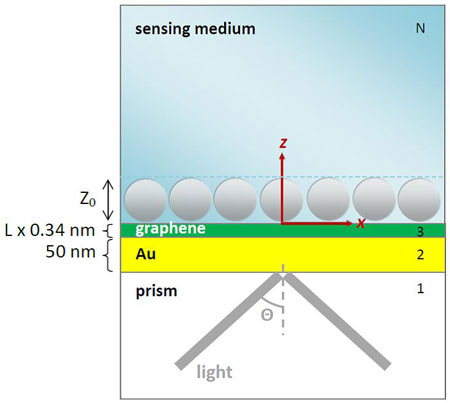| May 05, 2011 |
Highly sensitive graphene biosensors based on surface plasmon resonance
|
|
(Nanowerk News) Graphene, the one-atom-thick carbon lattice that is the subject of last year's Nobel Prize in Physics, has found application in surface plasmon resonance (SPR) biosensing.
|
|
Adding a few graphene layers onto the conventional gold-film SPR biosensor will boost up its sensitivity dramatically. The improved sensitivity comes from the graphene layer's increased adsorption of biomolecules and the graphene layer's optical modification to the SPR.
|
 |
| Fig. 1 The N-Layer model for surface plasmon resonance (SPR) biosensor: prism | Au (50 nm) | graphene (L 0.34 nm) | sensing medium, where L is the number of graphene layers, and z0 = 100 nm is the thickness of biomolecule layer.
|
|
Surface plasmon resonance (SPR) biosensors are optical sensors, which use surface plasmon polariton waves to probe the interactions between biomolecules and the sensor surface. In the conventional SPR biosensor configuration, a thin metallic film is coated on one side of the prism, separating the sensing medium and the prism. The metallic film is typically made from noble metals, such as gold and silver, which support the propagation of surface plasmon polariton at visible light frequencies. But, gold is usually preferred because it has good resistance to oxidation and corrosion in different environments.
|
|
However, biomolecules adsorb poorly on gold. This drawback limits the sensitivity of the conventional SPR biosensor.
|
|
An attractive way to improve the sensitivity of SPR biosensor is to functionalize the gold film with biomolecular recognition elements (BRE) in order to enhance the adsorption of biomolecules on the gold surface.
|
|
Here, we propose to use graphene as the BRE, where a sheet of graphene is coated on the gold surface in the conventional SPR biosensor setup. Graphene-on-Au (111) has been proposed and fabricated recently, which is shown to stably adsorb biomolecules with carbon-based ring structures (e.g. ssDNA).
|
|
This special property of graphene enables a greater refractive index change near the graphene | sensing medium interface than that of the conventional SPR biosensor. Moreover, the coating of the gold surface with graphene will also modify the propagation constant of surface plasmon polariton (SPP); thereby change the sensitivity to refractive index change.
|
|
For more detail, including an in-depth explanation of how the proposed graphene-on-gold SPR biosensor functions, please see the attached pdf.
|

